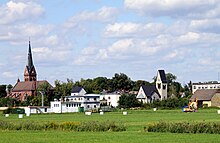Gogolin
| Gogolin | ||
|---|---|---|

|
|
|
| Basic data | ||
| State : | Poland | |
| Voivodeship : | Opole | |
| Powiat : | Krapkowicki | |
| Gmina : | Gogolin | |
| Area : | 20.35 km² | |
| Geographic location : | 50 ° 30 ' N , 18 ° 1' E | |
| Height : | 175 m npm | |
| Residents : | 6592 (December 31, 2016) | |
| Postal code : | 47-320 | |
| Telephone code : | (+48) 77 | |
| Economy and Transport | ||
| Street : | A4 Wroclaw - Cracow | |
| Rail route : | Kędzierzyn-Koźle-Opole | |
| Next international airport : | Katowice Airport | |
Gogolin [ gɔ'gɔlin ] is a small Upper Silesian town with 6000 inhabitants in the powiat Krapkowicki in the Opole Voivodeship in Poland . It is the seat of the town-and-country municipality of the same name with a little over 12,500 inhabitants.
geography
Gogolin is located around 20 kilometers southeast of Opole, immediately northwest of the city of Krapkowice (German Krappitz ), which lies at the mouth of the Osobłoga River in the Oder . The Autobahn 4 and the connecting road 409, which leads to Groß Strehlitz , run through Gogolin .
history
Gogolin was first mentioned in a document in 1223. Until the Industrial Revolution in the 19th century, Gogolin was a small agricultural settlement. With the construction of a railway line from Wroclaw to the Upper Silesian industrial area , the expansion of a previously established lime distillery was made possible, which later included numerous ring lime kilns . Gogolin's lime and cement deposits were significant. The craft of beer brewing also developed in Gogolin. In 1905 a gas works was built and street lighting was installed. After the First World War , Gogolin also became famous as a trading place for screws and wine , which is why wine festivals were held here until the end of the Second World War . From 1899 to 1901 the Catholic Herz-Jesu-Kirche was built, which initially became a branch of the old parish of Ottmuth and later became an independent parish . In 1908 the construction of the Protestant church followed.
In the referendum in Upper Silesia , which was accompanied by bloody uprisings , especially in Gogolin and the surrounding area , 1,262 votes (56.9%) were cast in Gogolin to remain with Germany, 955 votes were in favor of joining Poland. As a result, the village remained in the Weimar Republic .
In 1930 the town hall was built in the homeland security style. Gogolin was spared the large-scale renaming of places by the National Socialists, even if the place name is of Slavic origin.
After the decisions of the Potsdam Agreement of August 2, 1945, Gogolin was awarded with the area east of the Oder-Neisse line to Poland. 1958 Strzebniów and Karłubiec were incorporated. The city charter Gogolin received in 1967th
According to the last census in Poland from 2002, 17.0% of the community population belong to the German minority , another 8.6% described themselves as Silesians and 1952 people (15.8%) did not provide any information about their nationality. On April 30, 2010, additional official German place names were introduced in the community.
Population development
The population of Gogolin (including the manor district):
|
|
Attractions
- Herz-Jesu-Kirche, built 1899–1901
- Evangelical Church, built in 1908
- Karolinka and Karlik monument
- Market hall at ul. Krapkowicka
- Jewish cemetery at ul.Wyzwolenia, laid out in 1862
traffic
The Neustadt- Gogolin Railway used to branch off at Gogolin station on the Kędzierzyn-Koźle-Opole railway line .
local community
The town-and-country municipality (gmina miejsko-wiejska) Gogolin covers an area of 100.5 km² and is divided into the town and a number of villages.
City and community partnerships
- Schongau (Germany)
- Jablunkov (Czech Republic)
- Łodygowice ( Powiat Żywiecki , Poland)
Karolinka song
Gogolin is known today in Poland as Karolinka town . The Silesian folk song Poszła Karolinka do Gogolina is about Karolinka who wants to find her happiness in Gogolin. Her previous friend Karlik tries in vain to persuade her to return.
sons and daughters of the town
- Paul Tkotsch (1895–1963), Catholic auxiliary bishop in the Diocese of Berlin
- Klaus Sojka (1926–2009), German lawyer and politician at the DVU
- Christian Werner (* 1943), Catholic military ordinary of Austria, titular bishop
- Henryk Kroll (* 1949), member of the Sejm of the German minority.
literature
- Manfred Gabor: About Gogolin. Yesterday and today. In: Krappitzer Heimatblatt. No. 184 / Easter 2006. Alois Bialek (Ed.), Pp. 23–24
Web links
- Official website of the city of Gogolin (Polish, German)
- Text of the Karolinka song
Individual evidence
- ^ Results of the referendum ( Memento of March 4, 2016 in the Internet Archive ) accessed on February 18, 2010
- ↑ Polish Main Statistical Office (GUS) ( Memento from December 17, 2012 in the Internet Archive )
-
↑ Sources of population figures :
- Sources of population figures : 1784: books.google.de - 1830: books.google.de - 1844: sbc.org.pl - 1855, 1861: books.google.de - 1885: Gogolin . In: Meyers Konversations-Lexikon . 4th edition. Volume 7, Verlag des Bibliographisches Institut, Leipzig / Vienna 1885–1892, p. 471. - 1900: Gogolin . In: Meyers Großes Konversations-Lexikon . 6th edition. Volume 8, Bibliographical Institute, Leipzig / Vienna 1907, p. 80 . - 1910: gemeindeververzeichnis.de - 1933, 1939: Michael Rademacher: German administrative history from the unification of the Reich in 1871 to the reunification in 1990. strehlitz.html. (Online material for the dissertation, Osnabrück 2006). - 1995, 2000, 2005: stat.gov.pl






